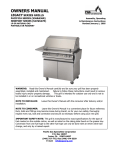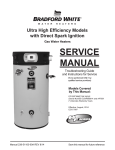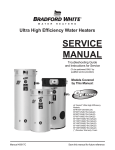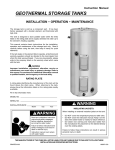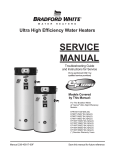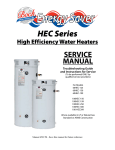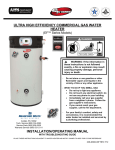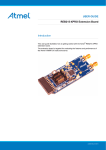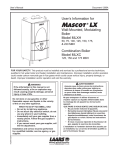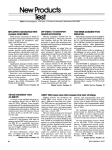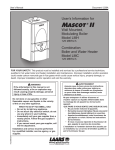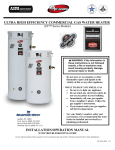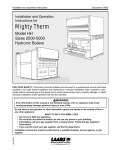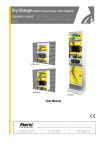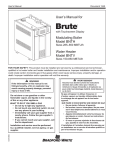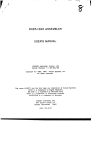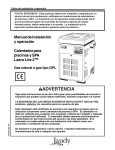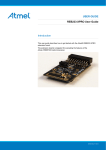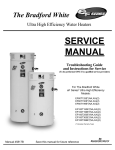Download UHE Service
Transcript
Service Manual Document 11019A Service Manual for U.H.E. Ultra High Efficiency Water Heaters UHE60T125E*(NA,XA)(2) UHE60T150E*(NA,XA)(2) UHE60T199E*(NA,XA)(2) UHE100T150E*(NA,XA)(2) UHE100T199E*(NA,XA)(2) UHE100T250E*(NA,XA)(2) UHE100T300E*(NA,XA)(2) UHE100T399E*(NA,XA)(2) (*) Denotes Warranty Years Troubleshooting Guide and Instructions for Service These instructions are to be stored next to the boiler for reference purposes. FOR YOUR SAFETY: This product must be installed and serviced by a professional service technician, qualified in hot water boiler installation and maintenance. Improper installation and/or operation could create carbon monoxide gas in flue gases which could cause serious injury, property damage, or death. Improper installation and/or operation will void the warranty. WARNING If the information in this manual is not followed exactly, a fire or explosion may result causing property damage, personal injury or loss of life. Do not store or use gasoline or other flammable vapors and liquids in the vicinity of this or any other appliance. WHAT TO DO IF YOU SMELL GAS • Do not try to light any appliance. • Do not touch any electrical switch; do not use any phone in your building. • Immediately call your gas supplier from a nearby phone. Follow the gas supplier's instructions. • If you cannot reach your gas supplier, call the fire department. Installation and service must be performed by a qualified installer, service agency, or gas supplier. AVERTISSEMENT Assurez-vous de bien suivres les instructions données dans cette notice pour réduire au minimum le risque d’incendie ou d’explosion ou pour éviter tout dommage matériel, toute blessure ou la mort. Ne pas entreposer ni utiliser d’essence ni d’autres vapeurs ou liquides inflammables dans le voisinage de cet appareil ou de tout autre appareil. QUE FAIRE SI VOUS SENTEZ UNE ODEUR DE GAZ: • Ne pas tenter d’allumer d’appareils. • Ne touchez à aucun interrupteur. Ne pas vous servir des téléphones dansle bâtiment où vous êtes. • Appelez immédiatement votre fournisseur de gaz depuis un voisin. Suivez les instructions du fournisseur. • Si vous ne pouvez rejoindre le fournisseur de gaz, appelez le sservice des incendies. L’installation et l’entretien doivent être assurés par un installateur ou un service d’entretien qualifié ou par le fournisseur de gaz. Page 2 LAARS Heating Systems U.H.E. Series Commercial Gas Ultra High Efficiency Water Heaters Table of Contents U.H.E.TM Page Service Procedure Introduction 3 --- How to use this manual 4 --- Tool required for service 4 --- Specifications 5 --- Sequence of Operation 8 --- Troubleshooting 10 --- Thermostat Circuit, Testing & Replacement 12 I Combustion System Testing and Replacement 18 II Burner Tube Inspection & Replacement 22 III Gas Valve Replacement 24 IV Blower Testing and Replacement 25 V Exhaust Pressure Switch Testing and Replacement 27 VI Hot Surface Igniter Testing and Replacement 30 VII Flame Sensor Testing and Replacement 32 VIII Ignition Module/Control Board Replacement 34 IX Transformer Replacement 35 X Vent Safety Switch Testing and Replacement 36 XI Anode & Flue Baffle Inspection and Replacement 38 XII Installation Check List 43 --- Heater Service Report 44 --- Parts List 45 --- Glossary of Terms 48 --- 2 U.H.E Service Manual Page 3 U.H.E. Series Commercial Gas Ultra High Efficiency Water Heaters Introduction The LAARS heating system Ultra High Efficiency Water Heater is designed to deliver a remarkable thermal efficiency rating in a quiet running unit with venting options that allow for installation flexibility. Several technologically advanced design features are incorporated in the design that will require additional knowledge on the part of the qualified service provider. The information in this manual will instruct service and maintenance professionals on the function, proper diagnosis and repair of LAARS Heating System Ultra High Efficiency Water Heater. The LAARS heating system Ultra High Efficiency Water Heater uses a low Nox premix power burner located at the top of the water heater to direct a turbulent flame down into a submerged combustion chamber. This turbulence causes a thorough mixing of gas and air for optimum combustion. The combustion gases then travel through a three pass flue system keeping the gases moving at a high velocity. The combination of high turbulence and velocity results in an optimum transfer of heat from the flue gases into the water. Burner operation is controlled using an electronic ignition module. The module monitors the status of the electronic thermostat, vent temperature limit switch, vent system pressure switches and a flame sensor to control output voltage to blower motor, hot surface igniter and gas valve. The module contains programming which determines the sequence of operation and timings for purge periods, trial for ignition, flame sensing and lockout. The module will also provide diagnostic information to help in determining the cause of system lockouts. The contents in this manual are detailed informational tools to assist in the proper diagnosis of the Ultra High Efficiency Water Heater operational faults. Please read this service manual completely and provide as much information regarding the Ultra High Efficiency Water Heater operation and installation specific concerns. 3 Page 4 LAARS Heating Systems It is intended for this manual to be used by qualified service personal for the primary purpose of troubleshooting analysis and repair of the LAARS heating system Ultra High Efficiency Water Heater. Understanding the sequence of operation section of this manual will contribute greatly to troubleshooting this product. An “Installation Check List” is shown on page 43. Compare the installation against the installation check list to confirm all requirements are met. An “UHE Service Report” is shown on page 44. Completing this form will assist in the troubleshooting efforts. Should you need to call for technical support, Please provide the information shown on this form to the support technician to insure accurate troubleshooting. Troubleshooting begins with “System Observation” to determine failure mode as indicated by the LED status of the ignition module. Troubleshooting continues with “Failure Modes and Probable cause” listed on page 10 directing the service provider to a series of test procedures to determine root cause of failure. Component replacement procedures directly follow the test procedures for a given component. In some difficult to diagnose conditions, it may be necessary to isolate the heater from the vent system to determine root cause. Contact Technical support immediately if diagnosis is not determined using the methods described in this service manual. Tools Required for Service Manometer: Two types available, a liquid “U” tube type or a digital (magna-helic) type. This device is used to measure gas and/or air pressures and vacuum. Multi-Meter: A digital type is strongly recommended. This device is used to measure electrical values. The meter you select must have the capability to measure volts AC, volts DC, Amps, micro-amps and ohms. Thermometer: Used to measure water temperature. An accurate thermometer is recommended. Water Pressure Gage: Used to measure water supply pressure. Also used to determine tank pressure by adapting to the drain valve of the heater. Jumper Leads: A length of wire (12" min.) with alligator clip at both ends. Various Hand Tools: Pipe wrench, channel locks, open end wrench set, 12" crescent wrench, Allen wrench set, torx bit set, screw drivers (common & phillips), long reach (12") magnetic tip phillips head screw driver #2 tip, ¼" nut driver, pliers (common & needle nose), socket set including a 1-1/16 deep well socket, wire cutters, wire strippers, wire crimpers, torpedo level, small shop vac, step ladder, and flashlight. 4 U.H.E Service Manual Page 5 Recovery GPH at Degree Rise DIMENSIONS (INCHES) Model No Input Rate BTU/h 1st Hr Del Gal @ 100°F Rise 40°F 100°F 140°F UHE60T125 UHE60T150 UHE60T199 UHE100T150 UHE100T199 UHE100T250 UHE100T300 UHE100T399 125,000 150,000 199,999 150,000 199,999 250,000 300,000 399,999 187 211 265 250 309 364 405 521 363.6 422.7 557.6 450.5 597 734.8 836.4 1,127 145.5 169.1 223 180.2 238.8 293.9 334.5 451 103.9 120.8 158 129 171 210 239 322 A B C D E F G H Stg Cap U.S. Gal Therm Eff % Ht Dia Flr to Vent Outlet Flr to Inlet Wtr Conn Flr to T&P Valve Conn Flr To Outlet Wtr Conn Flr. To Air Intake Flr to Gas Conn Front Wtr Conn Dia Space Heating Conn Dia Gas Conn Dia (NPT) T&P Valve Open (NPT) Shpg Wt (lbs) 60 60 60 100 100 100 100 100 96.0 93.0 92.0 99.1 98.5 97.0 92.0 93.0 57 57 57 77 5/8 77 5/8 77 5/8 77 5/8 77 5/8 28 ¼ 28 ¼ 28 ¼ 28 ¼ 28 ¼ 28 ¼ 28 ¼ 28 ¼ 5 5 5 5 5 5 5 5 13 13 13 13 13 13 13 13 40 40 40 60 60 60 60 60 42 ¼ 42 ¼ 42 ¼ 62 ¼ 62 ¼ 62 ¼ 62 ¼ 62 ¼ 52 ½ 52 ½ 52 ½ 73 1/8 73 1/8 73 1/8 73 1/8 73 1/8 53 ½ 53 ½ 53 ½ 74 ¾ 74 ¾ 74 ¾ 74 ¾ 73 ¼ 1½ 1½ 1½ 1½ 1½ 1½ 1½ 1½ 1 1 1 1 1 1 1 1 ¾ ¾ ¾ ¾ ¾ ¾ ¾ 1 ¾ ¾ ¾ ¾ ¾ ¾ ¾ 1 570 570 570 900 900 900 900 950 5 Page 6 Power supply LAARS Heating Systems Approved Gas Type Dedicated 120 VAC, 60 Hz, 15A, GFI Minimum 1" NPT for UHE100T399, all others ¾" NPT (schedule 40 black iron pipe recommended) Natural or Propane. Unit must match gas type supplied. Gas Pressure (Nat & L.P.) 14.0" W.C. maximum static, 4.5" W.C. minimum running (recommend 7.0" W.C. min running) Venting System Power vent, balanced direct vent or unbalanced direct vent. See vent tables on page 7 Approved Vent Materials PVC, CPVC or ABS Minimum Clearance for Servicing 18" from top, 24" from front, 4" sides and rear. Maximum Water Supply Pressure 150 PSI Thermostat Sensor 11,900 Ohms @ 70°F, ECO opens @ 201°F Max., ECO close @ 100°F Min. Temperature Dial Min. set point 5400-6600 ohms, Max set point 0-50 ohms. Thermostat Board Max temp 180°F, Min temp 91°F, 24VAC, 60Hz max. Ignition Module See page 9 Transformer 120VAC primary, 24VAC secondary, 40VA. Hot Surface Igniter 120VAC, 30-120 ohms @ room temperature. Flame Sensor Output Minimum 1 micro amp, Typical range 4 to 7 micro amps. Gas Valve Negative regulation, 24 VAC, ½" PSI max., 4.5" W.C. Minimum running inlet. Vent Safety Switch Normally closed, opens @ 350°F, manual reset. Blocked Vent Pressure Switch 24VAC, normally closed, opens when pressure increases to +2.70 W.C. Blower 120VAC, 60Hz, .6-1 amps, 6400 RPM. Combustion Levels CO2: 10-11%, CO: less then 0.04 percent (400 PPM) air free Gas Supply 6 U.H.E Service Manual Page 7 Vent Tables Balanced Direct Vent Systems PVC, CPVC Power Vented Systems PVC, CPVC Total length of intake piping and exhaust piping added together must not exceed “Maximum Combined Length” Shown below Total length of exhaust piping must not exceed “Maximum Vent Length” Shown below Maximum Combined Length (feet) Maximum Vent Length (feet) Model Number 3" 4" Model Number 3" 4" UHE60T125, UHE100T150 120' 170' UHE60T125, UHE100T150 120' 170' UHE60T150, UHE100T199 100' 150' UHE60T150, UHE100T199 100' 150' UHE60T199 80' 130' UHE60T199 80' 130' UHE100T250 80' 130' UHE100T250 80' 130' UHE100T300 60' 110' UHE100T300 60' 110' UHE100T399 50' 100' UHE100T399 50' 100' Unbalanced Direct Vent Systems Air intake CAN NOT exceed exhaust by more than 30 feet Notes: 1) Multiply the total number of 90° elbows (intake and exhaust) by 5 feet. Do not include the termination fittings or 3" condensate elbow. 2) Multiply the total number of 45° elbows (intake and exhaust) by 2 ½ feet. 3) Add this to the total length of straight pipe - intake and exhaust. 4) The sum total of all elbows and straight pipe - intake and exhaust must not exceed maximum lengths from tables above. Example: UHE100T199 A 3" Balanced Direct vent system has 30 feet of straight exhaust pipe and 30 feet of straight intake pipe. It has 3- 90° elbows in the exhaust and 3- 90° elbows in the intake. It has 1- 45° elbow in the exhaust and 1- 45° elbow in the intake. Therefore: 6- 90° elbows x 5 feet = 30 feet. 2- 45° elbows x 2½ feet = 5 feet. 60 feet of straight pipe + 30 feet + 5 feet = 95 feet. System is within “Maximum Combined Length” from table above. 7 Page 8 1 LAARS Heating Systems Thermostat calls for heat. Prior to energizing blower, ignition module checks to make sure the vent temperature switch is in the normally closed position. If the vent temperature switch is open, the control waits indefinitely for the temperature switch to close. 2 Blower energizes, pressure switch contacts are normally closed. If the pressure switch contacts are open, blower operates for up to 5 minutes waiting for contacts to close, then blower stops and flashes red PURGE LED indicating lock-out condition. 3 Blower pre-purge period (5 seconds) indicated by PURGE LED on the module 4 Igniter warm up (18 seconds), indicated by the IGNITER LED on the module. Note: The blocked vent pressure switch must be in the normally closed position for the ignition cycle to start. 5 6 Trial for Ignition (4 seconds, 3 trials). a) Flame establishing period (2.5 seconds), gas valve and igniter on, indicated by the IGNITER and VALVE LED on the module. b) Burner on, flame proving period (1.5 seconds, looking for minimum of 1 micro amps), indicated by the FLAME & VALVE LED on the module. Steady state operation. Ignition module monitors: - Thermostat circuit. - When thermostat opens, gas valve is shut down and post purge begins. - Safety circuit. - If vent temperature switch opens, gas valve is shut down, system will post purge and wait for switch to close before attempting re-ignition. - If the blocked vent pressure switch opens, indicating a blocked exhaust vent condition, the gas valve is shut down, blower shuts down for 30 seconds and is re-energized and system attempts re-ignition if the pressure switch is closed. Blower operates for 5 minutes to wait for pressure switch to close, then shuts off with purge light flashing (lock-out). Will restart in 1 hour to attempt to close the switch and restart ignition sequence. - Flame sensor circuit. - If flame is lost, gas valve is shut down, system will post purge and system attempts re-ignition. 7 Thermostat satisfied. 8 Burner off. 9 Blower post purge (15 seconds). 8 U.H.E Service Manual Page 9 Lockout Conditions Lockout conditions: The system will go into lock out mode for the following reasons: Blocked vent pressure switch contacts open: Check for obstruction in exhaust pipe and vent terminal. Check for blocked condensate trap or drain line. In cold climates, make sure drain is not frozen. No ignition after 3 attempts: a) Check inlet and outlet gas pressures (pressure taps located on top of gas valve). b) Igniter resistance too high (lower resistance preferred < 150 ohms). c) Misadjusted veturi screw (should be 6.5 turns out from bottom). d) Flame sense microamp not present (1.0 microamps minimum, should be 5 microamps or more). If burner lit, check flame rod for deposits. e) Check burner tube condition. Refer to section UHE-III for Burner Tube Inspection and Replacement. Ignition Module Specifications Control Functions: - Ignition & heating functions in response to thermostat. - Hot surface ignition using a microprocessor to control timing, flame sensing using flame rectification & ignition retries. - Monitoring of system pressure switches and limit switches. - Control of gas valve, inducer motor, and hot surface igniter element based on thermostat demand and status of safety inputs. - Diagnostic indicators to provide information on power to control and control status. - Non-interchangeable polarized plug-in connectors for all interconnections. Control Inputs: Control Outputs: - Thermostat call for heat. - Blocked vent pressure switch (normally closed) - Flame sensing. - Low voltage supply. - Line voltage supply. - Inducer motor - Hot surface igniter - Gas valve - Status indicator LEDs Power - Green Purge - Red Igniter - Red Valve - Red Flame - Red WIRING DIAGRAM IGNITION MODULE 9 Page 10 LAARS Heating Systems System Observation Is front panel power switch light on, indicating power? N WARNING 120 volt potential exposure. Use caution making voltage checks to avoid personal injury. Position front panel power switch to “ON” position. Y Is there 120VAC across switch? (see photo at right) Power Switch Y Light burned out, replace switch. Y Repair/replace wire harness to switch. N Is there 120VAC across terminal block? (see photo at right) Terminal Block N Determine power source problem and correct. Is ignition module power light on? N Refer to ignition module illustration, is there 120VAC going to module at locations P7(1) and P7(3)? Y N Y Replace ignition module. (see page 24) Refer to ignition module illustration, is there 24VAC going to module at locations P2(1) and P2(2)? Refer to ignition module Y illustration, is there 120VAC between P1(1) and P1(3)? N N Replace ignition module. (see page 24) Replace transformer. (see page 35) IGNITION MODULE Is ignition module power and flame light flashing? Y Supply voltage polarity is incorrect. N Reset heater by interrupting power. Reestablish power and Adjust thermostat to call for heat, tank must be cold. Allow heater to run through heating cycle. Did heater complete heating cycle and did blower post purge? N See next page Y System is OK. 10 U.H.E Service Manual Page 11 LED status & probable cause For models with Hot Surface Ignition Determine failure mode by observing flashing LED status on ignition module. LED status and probable cause shown below. * Denotes conditions that may require the water heater to be isolated from the vent system to determine root cause. LED STATUS Only power light is on and water heater will not function. Probable Cause* Exhaust pressure switch. (see page 27) Probable Cause Thermostat circuit. (see page 12) Probable Cause Vent safety switch. (see page 36) LED STATUS Purge light flashing. Probable Cause* Exhaust pressure switch. (see page 27) Probable Cause Blower. (see page 25) LED STATUS Valve light flashing. Probable Cause Hot surface igniter. (see page 30) Probable Cause* Combustion system. (see page 18) Probable Cause Flame sensor. (see page 32) LED STATUS Power & flame light flashing. Probable Cause Supply voltage polarity. 11 Page 12 LAARS Heating Systems IMPORTANT NOTE: This procedure assumes a cool tank WARNING 120 volt potential exposure. Use caution making voltage checks to avoid personal injury. Rotate temperature dial to highest setting. Refer to ignition module illustration, Is there 24VAC between P3(7) and P3(8)? Y OK, thermostat is calling for heat. N IGNITION MODULE Thermostat not calling Red Wire (N.O.) Turn off power to heater. Disconnect YELLOW and RED wires from the thermostat board at location N.O. and COM shown in photo at right. Use a jumper to connect these two wires together as shown in photo at right. Restore power to heater. Did heater cycle on? N See page 14 Yellow & Red wires shown jumpered Y Check thermostat sensor for proper resistance (OHMS) across blue wires. (See page 13) Are readings correct? (see photo at right) N Yellow Wire (COM) Replace thermostat sensor. (see page 12) Y Check sensor harness continuity. Is there continuity? N Replace harness. Thermostat Sensor Y Check temperature dial for proper resistance (OHMS) (See Appendix B, N temperature dial resistance) Are readings correct? (see photo at right) Replace temperature dial (potentiometer). (see page 16) Temperature Dial Y Check temperature dial harness continuity. Is there continuity? N Replace harness. Y Replace thermostat circuit board. (see page 15) 12 U.H.E Service Manual Page 13 APPENDIX - A Sensor Resistance at Various Temperatures Be Careful When Making Voltage Measurements or Jumping Terminals Not to Damage or Deform Connectors or Connector Pins. Draw Water From The T&P Valve. Compare Temperature With Temperature Ohms Chart Below. Example: If temperature of sensor is 84°F, then the resistance through the sensor would be 8449 (see shaded area). NOTE: Sensor resistance increases as the temperature falls. °F 40 50 60 70 80 90 100 110 120 130 140 150 160 170 180 190 200 0 26109 19906 15314 11884 9299 7333 5827 4663 3758 3048 2488 2043 1688 1402 1170 982 828 1 25400 19383 14925 11592 9078 7165 5697 4562 3679 2986 2439 2004 1656 1376 1150 965 814 2 24712 18876 14548 11308 8862 7000 5570 4464 3602 2925 2391 1966 1625 1351 1129 949 801 3 24045 18383 14180 11032 8653 6839 5446 4368 3527 2866 2344 1928 1595 1327 1110 933 788 In Degrees 4 23399 17905 13823 10763 8449 6683 5326 4274 3453 2808 2298 1891 1566 1303 1090 917 775 F 5 22771 17440 13477 10502 8250 6531 5208 4183 3382 2752 2253 1856 1537 1280 1071 901 762 6 22163 16990 13140 10248 8057 6383 5094 4094 3312 2697 2209 1820 1509 1257 1053 886 749 7 21573 16553 12812 10000 7869 6238 4982 4006 3244 2643 2166 1786 1481 1235 1035 871 737 8 21000 16128 12494 9760 7685 6098 4873 3922 3177 2590 2124 1753 1454 1213 1017 857 725 9 20445 15715 12185 9526 7507 5961 4767 3839 3112 2538 2083 1720 1427 1191 999 842 713 APPENDIX - B Temperature Dial Resistance Proper Readings Should Be 5400-6600 Ohms at Minimum Setting And 0-50 Ohms at Maximum. Be Careful When Making Voltage Measurements or Jumping Terminals Not to Damage or Deform Connectors or Connector Pins. 13 Page 14 LAARS Heating Systems WARNING 120 volt potential exposure. Use caution making voltage checks to avoid personal injury. Thermostat circuit. (continued from page 12) Check AC source to determine why there is no power. Replace ignition module. (see page 34) Y Refer to ignition module illustration, Is there 120VAC between P1(1) and P1(3)? N Refer to ignition module illustration, Is there 120VAC between P7(3) and P7(1)? N Y Refer to ignition module illustration, Is there 22 - 27VAC between P2(1) and P2(2)? N IGNITION MODULE Replace transformer. (see page 35) Y Refer to ignition module illustration, Is there 24VAC between P3(9) and P2(1). N Replace ignition module. (see page 34) Red Wires (Temperature Sensor) Y Check continuity through ECO, red wires of thermostat sensor. Check at temperature less than 160°F Is there continuity? (see photo at right) Y N Check wire harness continuity. Replace thermostat sensor or wire harness as necessary. (see page 17) Replace thermostat circuit board. (see page 15) 14 U.H.E Service Manual Page 15 Thermostat Board Replacement Procedure Step 1. Position main power switch to “OFF” Step 2. Disconnect (unplug) water heater from 120 volt power source. Step 3. Un-latch and remove top surround cover from top of heater. Step 4. Locate thermostat board on control panel. (see photo at right) WARNING 120 volt potential exposure. Isolate the appliance and reconfirm power is disconnected using a multi-meter. Thermostat Board Step 5. Carefully disconnect all wires from thermostat board. Note: it may be necessary to identify wires for proper re-connection. Mounting screw locations Step 6. Remove the two screws (Phillips head screw driver) that secure thermostat board to control panel. Step 7. Install new thermostat board to control panel using screws from step 6. Step 8. Carefully reconnect wiring per the wire diagram below. Reconfirm wire connections are correct prior to putting heater back in service Step 9. Restore 120 volt power supply to water heater and confirm proper operation following the lighting instructions on the lighting instruction label or the lighting instruction located in the installation and operating instruction manual. Step 10. Replace surround cover on top of heater. WIRING DIAGRAM 15 Page 16 LAARS Heating Systems Thermostat Potentiometer Replacement Procedure Step 1. Position main power switch to “OFF” Step 2. Disconnect (unplug) water heater from 120 volt power source. Step 3. Un-latch and remove top surround cover from top of heater. Temperature Adjusting Knob Loosen set screw of adjusting knob (small blade screw driver) and remove adjusting knob from potentiometer. (see photos at right) Step 4. Step 5. Remove retaining nut (½" wrench) and washer from potentiometer. (see photos at right) Step 6. From inside of surround area, remove potentiometer with gasket from side of surround. Notice how indexing tab on potentiometer assembles into locating hole of surround. (see photos below) WARNING 120 volt potential exposure. Isolate the appliance and reconfirm power is disconnected using a multi-meter. Loosen set screw with small blade screw driver Remove retaining nut Indexing Tab Locating Hole Potentiometer Wire Leads Step 7. Disconnect potentiometer wire leads. (see photo at right) Step 8. Install new potentiometer with gasket into side of surround. Be sure to assemble with indexing tab inserted into locating hole on side of surround (see photos above). Step 9. Reconnect wires to potentiometer. Note: Wire leads are interchangeable with either wire. Step 10. Restore 120 volt power supply to water heater and confirm proper operation following the lighting instructions on the lighting instruction label or the lighting instruction located in the installation and operating instruction manual. Step 11. Replace surround cover on top of heater. 16 U.H.E Service Manual Page 17 Thermostat Sensor (Thermistor) Replacement Procedure Step 1. Position main power switch to “OFF” Step 2. Disconnect (unplug) water heater from 120 volt power source. Step 3. Drain water heater down to a point below the top of the tank. Step 4. Un-latch and remove top surround cover from top of heater. Step 5. Fold back insulation just in front of burner to expose temperature sensor (see photo below). Step 6. Disconnect temperature sensor from harness (see photos at right). WARNING 120 volt potential exposure. Isolate the appliance and reconfirm power is disconnected using a multi-meter. Disconnect sensor from harness Hot Surface Ignition Models Insulation folded back to expose temperature sensor Step 7. Remove temperature sensor (1-1/16" hex, deep well socket) from heater. Note: Using a deep well socket will allow room inside socket for sensor connector and wires. Step 8. Apply thread sealing tape or applicable thread lubricant to threads of new sensor. Install new thermostat sensor and Connect to wire harness from step 6. Step 9. Fold insulation back into place. Be sure there are no wires in contact with burner. Step 10. Restore 120 volt power supply and water supply to water heater, check and repair any leaks found. Confirm proper operation following the lighting instructions on the lighting instruction label or the lighting instruction located in the installation and operating instruction manual. Step 11. Replace surround cover on top of heater. 17 Page 18 LAARS Heating Systems Observe burner operation through the sight glass located on the combustion insert mounting flange. Normal burner operation should ignite smoothly, without evidence of coughing or huffing upon ignition. The burner flame should be a blue flame near the burner surface in a uniform flame pattern. Occasional yellow or white streaks are normal. Note: On higher input models using metal fiber mesh burner (serial number “CK” and later) a red glow from the burner surface is normal. Verify Minimum Gas Supply Piping Requirements of: Minimum 1" NPT for UHE100T399, all others use ¾" NPT. (Schedule 40 black Iron Pipe recommended). Y N Reconfigure gas supply piping Inadequately sized regulator. With manometer, check inlet gas pressure. Is it stable N between 7" & 14" W.C. static? (heater not running) (see illustrations at right) N Is gas supply pressure regulator adjustable to Y maintain proper and stable setting? Adjust gas supply regulator Venturi adjustment Y Does inlet gas pressure drop more than 2" W.C. during burner ignition? WARNING Inlet gas pressure tap Removing screw from inlet gas pressure tap will immediately allow gas to flow from pressure tap. Y N WARNING 120 volt potential exposure. Use caution making voltage checks to avoid personal injury. Replace ignition module. (see page 34) N Do you see the igniter glowing through burner site glass during the warm up period? N Refer to ignition module illustration below, is there 120VAC across terminals P6(1) and P6(2)? (Note: Igniter LED must be lit during this check). Y IGNITION MODULE Y Volt meter set to OHM setting Is igniter resistance less than 150 Ohms (cold)? (see check igniter illustration) Y Proceed to next page N Replace hot surface igniter. (see page 30) Meter probe Hot surface igniter CHECK IGNITER RESISTANCE 18 U.H.E Service Manual Page 19 Observe burner operation through the sight glass located on the combustion insert mounting flange. Normal burner operation should ignite smoothly, without evidence of coughing or huffing upon ignition. The burner flame should be a blue flame near the burner surface in a uniform flame pattern. Occasional yellow or white streaks are normal. WARNING 120 volt potential exposure. Isolate the appliance and reconfirm power is disconnected using a multi-meter. Continued from previous page Refer to ignition module illustration below, is there 24VAC between P3(2) and P3(5) (blue and brown wires) during the flame establishing period? (Note: Valve LED must be lit during this check) Replace ignition module. (see page 34) N Y Can you hear or feel gas valve energize? Replace Rectifier harness and/or gas valve. (see page 24) N Y Turn VENTURI set screw clockwise until its bottomed out. Turn screw counter-clockwise 6-½ turns from bottom (see illustration below). Note: UHE100T399 models do not have a venturi screw. The gas regulator setting should be 1 - 1 ¼ turns out from bottom. IGNITION MODULE Clear obstruction N Y Does burner light smoothly, without evidence of coughing or huffing? Check for obstruction at inlet of gas valve. Is inlet free of obstruction? N Call for technical support Y Does flame LED on the module light and stay lit? N Check flame sensor, Is there 1 to 5 micro amps (min.) during 1.5 second flame proving period? (see page 32) Inlet gas pressure tap Does burner operate normaly until thermostat is satisfied? N Y Y Inspect burner tube, (see page 22) Venturi adjustment Y Y N Gas valve regulator System OK UHE100T399 Only N Replace flame sensor (see page 32) 19 Page 20 LAARS Heating Systems WARNING Heater components may be HOT when performing the following steps in this procedure. Take necessary precaution to prevent personal injury. Combustion System Removal Procedure Step 1. Position main power switch to “OFF”. Step 2. Disconnect (unplug) water heater from 120 volt power source. Step 3. Turn off gas supply to water heater. Step 4. Un-latch and remove surround cover from top of heater. Step 5. From the gas valve, disconnect the gas connection, PVC venting, Silicone tubing and wire harness. Step 6. WARNING 120 volt potential exposure. Isolate the appliance and reconfirm power is disconnected using a multi-meter. Gas valve wire harness Gas connection Disconnect wire harnesses flame sensor and Blower. Disconnect wire harness from hot surface igniter. Burner mounting screw (Total of 5) PVC vent connection Burner mounting insert Step 7. Remove the 5 bolts (½" socket) holding the burner mounting insert in place. Step 8. Carefully remove combustion assembly with gasket from water heater. Step 9. See next page for combustion system installation procedure. Burner tube Burner mounting insert gasket 20 U.H.E Service Manual Page 21 Combustion System Replacement Procedure Step 1. Fully inspect burner mounting insert gasket for the following: a) Tears d) Dirt or debris b) Missing material e) Other imperfections that would inhibit proper seal c) Cracks If gasket is NOT affected by any of the above, gasket replacement is not required. Step 2. Install combustion assembly using new gasket or fully inspected gasket from step 1. Secure combustion assembly at the burner mounting insert using screws from step 6 on previous page. Tighten screws evenly. Step 3. Reconnect wire harnesses to hot surface igniter, flame sensor, blower and gas valve. Step 4. Reconnect PVC venting, gas supply and silicone tubing to gas valve. Turn on gas supply to heater and check for gas leaks, repair any gas leaks found. Step 5. Restore 120 volt power supply to water heater and confirm proper operation following the lighting instructions on the lighting instruction label or the lighting instruction located in the installation and operating instruction manual. Step 6. Gas valve wire harness Replace surround cover on top of water heater. Gas connection Burner mounting screw (Total of 5) PVC vent connection Burner mounting insert Burner tube Burner mounting insert gasket 21 Page 22 LAARS Heating Systems WARNING Heater components may be HOT when performing the following steps in this procedure. Take necessary precaution to prevent personal injury. Burner Tube Removal Procedure Step 1. Position main power switch to “OFF”. Step 2. Disconnect (unplug) water heater from 120 volt power source. Step 3. Turn off gas supply to water heater. Step 4. Un-latch & remove surround cover from top of heater. Step 5. From the gas valve, disconnect the gas connection, PVC venting, wire harness and silicone tubing. Step 6. Disconnect wire harness from blower assembly. WARNING 120 volt potential exposure. Isolate the appliance and reconfirm power is disconnected using a multi-meter. HOT SURFACE IGNITER/SPARK ROD Step 7. Remove the two screws holding each the hot surface igniter and flame sensor in place (long reach magnetic Phillips screw driver). Carefully remove hot surface igniter and flame sensor from combustion assembly. Step 8. Remove the 4 nuts (7/16" wrench) holding the burner transition in place. Lift the blower/gas valve transition assembly from burner mounting insert, remove gasket and set aside. Step 9. Remove burner tube from burner mounting insert. See next page for burner tube inspection procedure. BURNER TRANSITION MOUNTING NUTS 22 U.H.E Service Manual Page 23 WARNING Heater components may be HOT when performing the following steps in this procedure. Take necessary precaution to prevent personal injury. Burner Tube Inspection Step 1. Inspect burner tube as follows (BSI ceramic fiber mesh burner, water heaters prior to serial number “CK”) : a) Visually inspect ceramic fiber mesh, mesh should be uniform in appearance without large gaps, tears or fraying. Mesh should have uniform pattern allowing for unrestricted gas flow. b) Gently squeeze burner tube, Burner tube should feel firm without any soft areas around the sides or at the bottom. c) Visually inspect inside burner tube, Burner tube should be intact with no areas of deterioration. Ports should be free of any debris. Inspect burner tube as follows (Acotech metal fiber mesh burner, water heaters with “CK” serial number or later). a) Outer fiber mesh should be uniform with no tears or deterioration. Step 2. If burner tube is affected by any of the above, replacement is required. Refer to burner tube replacement procedure below. Burner Tube Replacement Procedure Note: New metal fiber mesh burner (Acotech) is the replacement burner for the BSI ceramic fiber sock burner. The length of burner will not be the same as the previous BSI burner. Provide the model and serial number for the correct replacement burner. Step 1. Fully inspect burner flange gaskets, igniter and flame sensor gaskets for the following: a) Tears d) Dirt or debris b) Missing material e) Other imperfections that would inhibit proper seal c) Cracks If gaskets are NOT affected by any of the above, gasket replacement is not required. Step 2. Install burner tube with gaskets into burner mounting insert. Be sure gasket surfaces are free of debris. Step 3. Reconnect the blower/gas valve/transition assembly to burner mounting insert. Secure using nuts from step 8 on previous page. Step 4. Carefully reinstall flame sensor with gasket and hot surface igniter with gasket and secure with screws from step 7 on previous page. Reconnect wire harnesses to sensor and igniter. Step 5. Reconnect wire harnesses to blower motor and to gas valve. Step 6. Reconnect PVC venting, gas supply and silicone tubing to gas valve. Turn on gas to heater and check for gas leaks, repair any gas leaks found. Step 7. Restore 120 volt power supply to water heater and confirm proper operation following the lighting instructions on the lighting instruction label or the lighting instruction located in the installation and operating instruction manual. Step 8. Replace surround cover on top of water heater. 23 Page 24 LAARS Heating Systems Gas Valve Replacement Procedure WARNING 120 volt potential exposure. Isolate the appliance and reconfirm power is disconnected using a multi-meter. Step 1. Position main power switch to “OFF”. Step 2. Disconnect (unplug) water heater from 120 volt power source. Step 3. Turn off gas supply to water heater. Step 4. Un-latch & remove surround cover from top of heater. Step 5. From the gas valve, disconnect the gas connection, PVC venting, wire harness and silicone tubing. Step 6. Remove the 2 gas valve mounting screws (Torx bit) located at the 11:00 O-clock & 5:00 O-clock position on the venturi mounting flange and remove gas valve from water heater. Step 7. Remove any residual gasket material from blower and venturi mounting flange. Blower / gas valve gasket Gas valve wire harness Gas valve assembly Gas valve mounting screws (2 places) Blower Venturi mounting flange Venturi inlet Step 8. Install new gas valve with new gasket screws from step 6. provided. Secure gas valve in place using Step 9. Reconnect PVC venting, gas supply, silicone tubing & wire harness to gas valve. Turn on gas supply to heater and check for gas leaks, repair any gas leaks found. Step 10. Restore 120 volt power supply to water heater and confirm proper operation following the lighting instructions on the lighting instruction label or the lighting instruction located in the installation and operating instruction manual. Step 11. Replace surround cover on top of water heater. 24 U.H.E Service Manual Page 25 Is there 120VAC across the white and black wires at the terminal block ? (see photo at right) Y Does blower energize? Y Refer to ignition module/control board illustration. Is there 120VAC between P5(1) and P5(3)? Replace ignition module/ control board. N Y N 120VAC check at Terminal Block N Determine power source problem and correct Black wire leading to blower motor looped through amprobe. Is there 120VAC across the white and black wires at the terminal block ? N Check amp draw through BLACK wire lead of blower motor. Is there .6 to 3.0 amps? Y Is Blower wheel secured to Y blower motor shaft? Call technical support. N Y N Replace blower. (see “Blower Replacement Procedure”) Refer to ignition module/ control board illustration. Is there 120VAC between P5(1) and P5(3)? N Hot Surface Ignition Models ONLY: Refer to ignition module, is there 24 VAC between P3(7) and ground? N Y Is there 120VAC across the white and black wires at the blower? (see photo at right) Thermostat not calling for heat. (see page 12) N Y Hot Surface Ignition Models: Are safety circuits in normal position? N Y Replace ignition module/ control board. Checking for 120VAC (Black & White Wires) Correct safety circuit problem per safety circuit trace (see page 27). Repair/replace wire harness. Y Replace blower. (see page 25) IGNITION MODULE 25 Page 26 LAARS Heating Systems Blower Replacement Procedure WARNING 120 volt potential exposure. Isolate the appliance and reconfirm power is disconnected using a multi-meter. Step 1. Position main power switch to “OFF”. Step 2. Disconnect (unplug) water heater from 120 volt power source. Step 3. Turn off gas supply to water heater. Step 4. Un-latch & remove surround cover from top of heater. Step 5. Disconnect wire harness from blower. Step 6. Disconnect intake vent and gas supply from gas valve assembly. Step 7. Remove the 2 gas valve mounting screws (Torx bit) located at the 11:00 O-clock & 5:00 O-clock position on the venturi mounting flange. Step 8. Remove The 4 blower flange mounting screws (5/32 Allen wrench) and remove blower from transition flange. Blower Blower / gas valve gasket Gas valve assembly Gas valve mounting screws 2 places. Blower flange mounting screws Blower / transition gasket Venturi mounting flange Transition flange Venturi inlet Step 9. Remove any residual gasket material from venturi mounting flange and transition flange. Step 10. Install new blower with new gasket provided. Secure blower in place using screws from step 8. Step 11. Reconnect gas valve assembly to blower with new gasket provided. Secure gas valve in place using screws from step 7. Step 12. Reconnect intake vent and gas line to gas valve assembly and check for gas leaks repair any leaks found. Step 13. Reconnect wire harness to blower assembly, restore 120 volt power supply & Gas supply to water heater and confirm proper operation following the lighting instructions on the lighting instruction label or the lighting instructions located in the installation and operating instruction manual. Step 14. Replace surround cover on top of water heater. 26 U.H.E Service Manual Page 27 Exhaust Pressure Switch Testing and Replacement Sequence of operation: The blocked vent pressure switch monitors the pressure in the exhaust tube. The switch contacts are normally closed and will not open unless there is a blockage in the exhaust venting or terminal (snow, ice, debris). If the blocked vent pressure switch contacts open after the thermostat initiates the blower, the blower will remain on for to 5 minutes waiting for the contacts to close. If the contacts remain open, the blower will stop and the PURGE LED will flash for hot surface ignition models. WARNING 120 volt potential exposure. Use caution making voltage checks to avoid personal injury. LED Status Only power LED is on, or Purge LED flashing. Safety Circuit Trace Does blower energize? Is there continuity Through GREY wire leads of heater side safety circuit harness? (see photo below) N Y Call technical support. N Does heater function? Y Verify proper switch operation. (see page 36) Y Is there continuity through RED wire leads of heater side safety circuit harness? (see photo below) N Safety Circuit OK, (see page 36) Y Replace exhaust pressure switch (see page 29) Y N Check PURGE LED status on ignition module, Flashing after 45 seconds? Depress reset button on vent safety switch. Is Y there continuity across high limit switch? (see photo below) Control side harness Heater side harness N Replace vent safety switch. (see page 37) Check PURGE LED status. On within 5 minutes? Y Pressure switch is OK. N Call for technical support. N Flashing after 5 minutes? Error code 29 again? Y Check blower for proper operation (see page 25) Is blower OK? N Correct blower problem (see page 25) Y Reset button Refer to “Check Collector Pressure” (see next page) Note: HOT SURFACE IGNITION MODELS ONLY - The blocked vent pressure switch must be used with the revised ignition control, identified with a yellow label. WARNING Make sure exhaust collector compartment is not overheating (350°F) before resetting vent safety switch. If there is evidence the collector compartment is overheating, CALL TECHNICAL SUPPORT. 27 Page 28 LAARS Heating Systems Exhaust Pressure Switch Testing and Replacement Check Exhaust Tube Pressure With monometer, take a reading at the exhaust tube pressure tap location. N Is value negative (-) or slightly postitive (see illustration below). Y Is exhaust venting system blocked or obstructed? Also check condensate elbow and drain. Y Clear obstruction. Determine cause and correct. N Is vent system total length compliant with vent tables in the instruction manual? Y N Reconfigure vent system to be compliant with vent tables (see “Specifications”). Replace blocked vent switch. (see page 29) With ohmmeter check N pressure switch for continuity. Contacts should be closed. Is pressure in exhaust tube near 2.7" w.c. or more? If so, correct blockage (above). If exhaust pressure is low (0.40" or less), replace pressure switch. Y Pressure switch O.K. Exhaust Tube pressure tap location Exhaust tube at bottom of heater 28 U.H.E Service Manual Page 29 Exhaust Pressure Switch Testing and Replacement Exhaust Pressure Switch Replacement Procedure Step 1. Position main power switch to “OFF” position. Step 2. Loosen adhesive backed rubber escutcheon from service panel access cover and slide escutcheon back along exhaust pipe to allow for removal of cover. Step 3. Remove screws from service panel access cover (¼" nut driver) and remove cover from heater. (see photos at right) Step 4. Disconnect silicone tubing and wire leads from pressure switch. (see photos at right) Step 5. Remove pressure switch mounting screws (5/16" wrench) and remove pressure switch. Step 6. Assemble new pressure switch to heater using screws from step 5. Step 7. Step 8. Step 10. Pressure switch mounting screw 5/16 hex head Wire leads Reconnect wire leads. Note: wire leads are interchangeable with either terminal. Reconnect silicone tubing to pressure switch as follows: a) Step 9. Rubber escutcheon Silicone tubing Exhaust pipe tubing connects to single tap located on switch Restore 120 volt power supply to water heater and confirm proper operation following the lighting instructions on the lighting instruction label or the lighting instructions located in the installation and operating instruction manual. Exhaust Tube pressure tap location Reinstall service panel access cover and rubber escutcheon. 29 Page 30 LAARS Heating Systems Hot surface Igniter Testing Procedure WARNING 120 volt potential exposure. Use caution making voltage checks to avoid personal injury. Igniter may be too hot to handle, take necessary precautions Is igniter resistance less than 150 Ohms (cold)? (see “check igniter resistance” below) N Replace hot surface igniter (see page 30) Y Refer to ignition module illustration below, is there 120VAC across terminals P6(1) and P6(2)? Y (Check during igniter warm up period, indicated by the igniter LED glowing on the ignition module). Check harness connection from igniter to ignition module. N Replace ignition module. (see page 34) Volt meter set to OHM setting Meter probe Hot surface igniter CHECK IGNITER RESISTANCE IGNITION MODULE 30 U.H.E Service Manual Page 31 Hot surface Igniter Replacement Procedure Step 1. Position main power switch to “OFF” Step 2. Disconnect (unplug) water heater from 120 volt power source. Step 3. Un-latch & remove surround cover from top of heater. Step 4. Fold back insulation in front of combustion assembly to expose hot surface igniter. (see photo at right) Step 5. Disconnect igniter wire leads from ignition module. Step 6. Remove the 2 igniter mounting screws (magnetic tip, long reach Phillips screw driver) and remove igniter and gasket from transition base flange. Step 7. Remove any residual gasket material from transition base flange. Note: New replacement igniter will not have a shield over element. Handle carefully to prevent breakage. Step 8. WARNING 120 volt potential exposure. Isolate the appliance and reconfirm power is disconnected using a multi-meter. Note: Do not handle igniter element or allow foreign material to come in contact with element. Hot Surface Igniter Install new igniter with new gasket provided using screws from step 5. Arrange igniter flange with offcenter hole towards front of heater. Off-center mounting hole Heater front Igniter mounting screws Transition base flange Igniter flange Igniter gasket Igniter filament Step 9. Reconnect igniter wire harness. Step 10. Fold insulation back into place. Be sure no wires are in contact with burner flange. Step 11. Restore 120 volt power supply to water heater and confirm proper operation following the lighting instructions on the lighting instruction label or the lighting instructions located in the installation and operating instruction manual. Step 12. Replace surround cover on top of water heater. 31 Page 32 Flame Sensor Testing Procedure Refer to illustration below, is there a minimum of 1 micro amp during 1.5 second flame proving period? LAARS Heating Systems WARNING 120 volt potential exposure. Use caution making voltage checks to avoid personal injury. Flame sensor may be too hot to handle, take necessary precautions Refer to ignition module/control board illustration.(24 volts should maintain beyond the 1.5 second flame proving period.) Is there 24 volts AC at locations P3(2) & P3(5)? Y N Y Flame sensing circuit OK N With flame sensor Disconnected from ignition module, check continuity to ground. Is there continuity to ground? Replace flame sensor with gasket and/or wire lead. (see page 33) Y Call for technical support N Remove flame sensor from water heater. Check continuity from tip of flame sensor to end of wire lead. Is there continuity? Y Is flame sensor free of oxidation? N Clean or replace flame sensor with emery cloth. (see page 33) N N Y Is ceramic of flame sensor cracked? Y Replace flame sensor. (see page 33) Volt meter set to Micro amps setting (µA) Meter probe Flame sensor terminal Meter probe Flame sensor terminal on ignition module. 32 U.H.E Service Manual Page 33 Flame Sensor Replacement Procedure Step 1. Position main power switch to “OFF” Step 2. Disconnect (unplug) water heater from 120 volt power source. Step 3. Un-latch & remove surround cover from top of heater. Step 4. Fold back insulation in front of combustion assembly to expose flame sensor. (see photo at right) Step 5. Disconnect wire lead from flame sensor. Step 6. Remove the 2 sensor mounting screws (magnetic tip, long reach Phillips screw driver) and remove flame sensor & gasket from transition base flange. Step 7. Remove any residual gasket material from transition base flange. Step 8. WARNING 120 volt potential exposure. Isolate the appliance and reconfirm power is disconnected using a multi-meter. Flame sensor Install new flame sensor with new gasket provided using screws from step 6. Arrange flame sensor with hook towards burner. Flame sensor mounting screws Flame sensor Flame sensor gasket Arrange hook of sensor towards burner Transition base flange Step 9. Reconnect flame sensor wire. Step 10. Fold insulation back into place. Be sure no wires are in contact with burner flange. Step 11. Restore 120 volt power supply to water heater and confirm proper operation following the lighting instructions on the lighting instruction label or the lighting instructions located in the installation and operating instruction manual. Step 12. Replace surround cover on top of water heater. 33 Page 34 LAARS Heating Systems Ignition Module Replacement Procedure WARNING 120 volt potential exposure. Isolate the appliance and reconfirm power is disconnected using a multi-meter. Step 1. Position main power switch to “OFF”. Step 2. Disconnect (Unplug) water heater from 120 Volt power source. Step 3. Un-latch & remove surround cover from top of water heater. Step 4. Locate Ignition module on control panel inside surround area. (see photo below) Ignition Module located on control panel Note: Replacement hot surface ignition module works on all UHE models prior to and later than “CF” serial numbers. Direct spark ignition models use a different control board (detailed in following section). Step 5. Carefully disconnect all wire harness connection to ignition module. Connection are non-interchangeable to insure proper reinstallation. Step 6. Remove the 3 screws (Phillips screw driver) holding the ignition module in place and remove ignition module from control panel. Step 7. Install new ignition module and secure in place with screws from step 6. Step 8. Carefully reconnect all wire harness connection to ignition module. Connection are non-interchangeable to insure proper reinstallation. Step 9. Restore 120 volt power supply to water heater and confirm proper operation following the lighting instructions on the lighting instruction label or the lighting instruction located in the installation and operating instruction manual. Step 10. Replace surround cover on top of water heater. 34 U.H.E Service Manual Page 35 Transformer Replacement Procedure Step 1. Position main power switch to “OFF”. Step 2. Disconnect (Unplug) water heater from 120 Volt power source. Step 3. Un-latch & remove surround cover from top of water heater. Step 4. For Hot Surface Ignition models, refer to ignition module illustration below, Disconnect wire harness P1 labeled “PRIMARY” and P2 labeled “SECONDARY” from ignition module. Step 5. WARNING 120 volt potential exposure. Isolate the appliance and reconfirm power is disconnected using a multi-meter. Step 3 Disconnect harness “P1” & “P2” from ignition module Disconnect secondary leads (blue & yellow wire) from thermostat board. Note the blue wire is connected to 24 volt “HOT” terminal. (see photo below) Step 5 Disconnect blue & yellow wire from thermostat board. Note blue wire is connected to 24 volt “HOT” terminal. Ignition module Thermostat board Step 6. Remove the 2 screws ( short Phillips screw driver) holding the transformer in place and remove transformer from control panel. (see photo below) Step 7. Install new transformer and secure in place with screws from step 6. Step 8. Reconnect wire harness P1 & P2, connections are non-interchangeable to insure proper reconnection. Step 9. Reconnect blue & yellow wire leading from the P2 connection on ignition module to thermostat board. Note the blue wire must connect to the 24 volt “HOT” terminal. (see photo at right) Step 10. Step 11. Restore 120 volt power supply to water heater and confirm proper operation following the lighting instructions on the lighting instruction label or the lighting instruction located in the installation and operating instruction manual. Step 6 Remove transformer mounting screws Thermostat board 24 volt common, yellow wire connection 24 volt Hot, blue wire connection Replace surround cover on top of water heater. 35 Page 36 LAARS Heating Systems Sequence of operation: With the thermostat calling for heat, prior to energizing blower, the ignition module checks the vent safety switch for normal switch position of normally closed. If the vent safety switch contacts are open, (not in normal position), the ignition module waits indefinitely for contact to close, The vent safety switch must be manually reset to close the switch contacts. WARNING 120 volt potential exposure. Use caution making voltage checks to avoid personal injury. Control side harness Heater side harness Is there continuity Through GREY Y Lead wires of heater side harness? (see photo at right) Locate harness connection. (see photo at right) N Call technical support. N Does heater function? Y Depress reset button on high limit switch. Is Y N there continuity across high limit switch? (see photo below) Replace vent safety switch (see page 37) System OK N Reset heater, observe heating cycle. Does switch open? N Is temp over 350°F? Y Y Does switch open prior to 350°F? Y N DO NOT OPERATE HEATER System over heating, immediately contact technical support. Replace vent safety switch (see page 37) Reset button WARNING Make sure exhaust collector compartment is not overheating (350°F) before resetting vent safety switch. If there is evidence the collector compartment is overheating, CALL TECHNICAL SUPPORT. 36 U.H.E Service Manual Page 37 Vent Safety Switch Replacement Procedure Step 1. Position main power switch to “OFF”. Step 2. Loosen adhesive backed rubber escutcheon from service panel access cover and slide escutcheon back along exhaust pipe to allow for removal of cover (see photos at right). Step 3. Remove screws from service panel access cover (¼" nut driver) and remove cover from heater (see photos at right) Step 4. Disconnect wire leads from vent safety switch (see photo at right). Step 5. Remove the 2 switch mounting screws (Phillips screw driver) and nuts (5/16 wrench) and remove switch from heater. Step 6. Install new switch using screws from step 5. Step 7. Reconnect wire leads. Note: wire leads are interchangeable with either switch terminal. Rubber escutcheon Vent safety switch Step 8. Restore 120 volt power supply to water heater and confirm proper operation following the lighting instructions on the lighting instruction label or the lighting instruction located in the installation and operating instruction manual. Step 9. Reinstall service panel access cover and rubber escutcheon. 37 Page 38 LAARS Heating Systems Disassembly Procedure for Access to Anodes & Flue Baffles WARNING Heater components may be HOT when performing the following steps in this procedure. Take necessary precaution to prevent personal injury. WARNING 120 volt potential exposure. Isolate the appliance and reconfirm power is disconnected using a multi-meter. Step 1. Position main power switch to “OFF”. Step 2. Disconnect (Unplug) water heater from 120 Volt power source. Step 3. Un-latch & remove surround cover from top of heater. Step 4. Disconnect wire harnesses to allow for removal of control panel. Note: Where ever possible, rather than disconnecting at the control panel, follow wire harness away from control panel and disconnect at control component location. Step 5. Remove the three control panel mounting screws (¼” nut driver) and remove control panel from the water heater (see photos below). Remove Control Panel Control Panel Mounting Screw Step 6. Completely remove insulation (two pieces) from top of heater to expose collector cover Step 7. Remove all collector cover screws (5/16" socket) and remove collector cover (see photos at right). Collector cover Step 8. Photo 44 shows heater with collector cover removed allowing access to anode rods and flue baffles. a) for anode service, see page 39. b) for flue baffle service, see page 40. c) for powered anode service, see page 41. Note: UHE100T399 models have only 1 anode rod under the 2nd pass collector cover. Anode locations Flue baffles 38 U.H.E Service Manual Page 39 Anode inspection and replacement WARNING Heater components and stored water may be HOT when performing the following steps in this procedure. Take necessary precaution to prevent personal injury. Step 1. Turn off water supply and drain water heater. Step 2. Disassemble water heater per “Disassembly Procedure for Access to Andoes & Flue Baffles”. Step 3. Locate and remove anode rods from heater (1-1/16 hex socket). Step 4. Visually inspect anode rod. Anode rod should show signs of depletion, this is normal. If the depletion is ½ of the original diameter (approximately ¾" diameter), replacement is recommended. If any of the steel core of the anode is exposed, replacement is recommended. Step 5. Upon completion of inspection or subsequent replacement, apply thread sealing tape or other thread compound to threads of anode and reinstall into heater. Restore water supply and check for and repair any leaks found. Step 6. Reinstall collector cover per “Collector Cover Installation Procedure”. Step 7. Reinstall collector insulation and control panel, reconnect control panel wire harnesses. Step 8. Restore 120 volts to water heater and verify proper heater operation following the instructions on the lighting instruction label or the lighting instruction located in the installation and operating instruction manual. Step 9. Replace surround cover on top of water heater. 39 Page 40 LAARS Heating Systems Flue baffle inspection and replacement WARNING Heater components may be HOT when performing the following steps in this procedure. Take necessary precaution to prevent personal injury. Step 1. Disassemble heater per “Disassembly Procedure for Access to Anodes & Flue Baffles”. Step 2. Remove flue baffles from heater (pliers) (8 two inch baffles & 2 four inch baffles). Step 3. Visually inspect flue baffles. Flue baffles should show signs of oxidation, this is normal. If the oxidation has deteriorated any portion of the flue baffle, replacement is recommended. If any restrictors are missing, replacement is recommended. Step 4. Upon completion of inspection or subsequent replacement, reinstall flue baffles into heater. Step 5. Reinstall collector cover per “Collector Cover Installation Procedure” see page 42. Step 6. Reinstall collector insulation and control panel, reconnect control panel wire harnesses. Step 7. Restore 120 volts to water heater and verify proper heater operation following the instructions on the lighting instruction label or the lighting instruction located in the installation and operating instruction manual. Step 8. Replace surround cover on top of water heater. 40 U.H.E Service Manual Page 41 Powered Anode Replacement for UHE100T399 only Powered Anode Replacement UHE100T399 models only WARNING Heater components may be HOT when performing the following steps in this procedure. Take necessary precaution to prevent personal injury. The powered anode control module is located on the right vertical side of the control panel inside the surround panel. The control has a LED indicator light to show the status of operation. When the tank is filled with water and the power supply is on to the water heater, the light should have a steady green glow to indicate that protection current is flowing and operating normally. If the indicator light is not glowing, the power supply to the water heater or powered anode system is disconnected. Step 1. Check the power supply or wire connections to the powered anode control. Step 2. Indicator light diagnostic codes: a) If the control is flashing red, then there is a malfunction with the powered anode system. Make sure there are no bare spots in the wire insulation to the powered anode rods. Step 3. Check all electrical connections. The powered anode rods are insulated from the water heater tank in the bushing. a) With an ohmeter, check continuity between the powered anode terminal and the bushing. There should not be continuity. If there is continuity, replace the powered anode assembly. Volt meter set to OHM setting 41 Page 42 LAARS Heating Systems Collector Cover Installation Procedure Step 1. Remove old silicone from top surface of collector flange and collector cover. Step 2. Apply ¼" bead of Ultra Copper Silicone around entire collector flange surface. Allow caulk to “cure” for 10 minutes. Step 3. Carefully reinstall collector cover, tighten screws evenly. Step 4. Allow a minimum of 6 hours before putting heater back in service. Apply ¼" bead of Ultra Copper Silicone around entire collector flange surface 42 U.H.E Service Manual Page 43 Product Handling - Carefully uncrate the heater. Move in place with a hand truck (Do not use the venting pipes for handles). Electrical Requirements - Make sure there is 120 volts line voltage. Line voltage must be properly polarized. Adequate ground supplied to the heater. Venting Requirements - All venting must stay within the required lengths and diameter (see table below). Proper support of the venting pipe is a MUST (every 5ft vertical and 3ft horizontal). Termination must be located to prevent re-circulation of flue gases. Medium to long sweep 90° elbows or straight exhaust terminal coupling recommended. Gas Requirements - Gas piping sized adequately, ¾" or larger to heater or 1" or larger for UHE100T399 models. Install a properly sized regulator (if unknown, assure an adequate volume of gas is available). 7" W.C. is required when the unit is running. Gas pressure must stay below 14" W.C. static pressure. Pressure drops between static pressure and operating flow should be less than 3" W.C. Condensate Requirements - Condensate line needs to slope to a drain at a minimum of ¼" per foot. Make sure the condensate line does not have the potential to freeze. If using more than one heater and using a common condensate line, make sure the condensate line is properly sized. Service/Mechanical Room - Provide adequate space for servicing heater. Leave room to get to the top and bottom pressure switches as well as enough overhead room to remove the anode rods for servicing (18" min.). Vent tables Balanced Direct Vent Systems PVC, CPVC Power Vented Systems PVC, CPVC Total length of intake piping and exhaust piping added together must not exceed “Maximum Combined Length” Shown below Total length of exhaust piping must not exceed “Maximum Vent Length” Shown below Maximum Combined Length (feet) Maximum Vent Length (feet) Model Number 3" 4" Model Number 3" 4" UHE60T125, UHE100T150 120' 170' UHE60T125, UHE100T150 120' 170' UHE60T150, UHE100T199 100' 150' UHE60T150, UHE100T199 100' 150' UHE60T199 80' 130' UHE60T199 80' 130' UHE100T250 80' 130' UHE100T250 80' 130' UHE100T300 60' 110' UHE100T300 60' 110' UHE100T399 50' 100' UHE100T399 50' 100' Unbalanced Direct Vent Systems Air intake CAN NOT exceed exhaust by more than 30 feet Note: each 3" & 4" 90° Elbow is equivalent to 5 feet of straight pipe. Note: each 3" & 4" 45° Elbow is equivalent to 2.5 feet of straight pipe. 43 Page 44 LAARS Heating Systems R Date Service Provider Model Number Phone Number Serial Number Venting (PVC, CPVC): Vent size 3" or 4" Intake 90's (qty) Intake 45's (qty) Length of straight pipe (intake) Exhaust 90's (qty) Exhaust 45's (qty) Length of straight pipe (exhaust) Gas Line: Gas Pressure: Venturi: Size & material Static Setting from Bottom in Turns Distance from meter to water heater Running Inlet Manifold Electrical: Line Voltage Low Voltage Igniter Resistance: Polarity Flame Sense Micro -Amps: LED Flashing Y or N Spark Gap: ___________ Which One(s) Error Codes on Control Display (Direct Spark Ignition System Only): __________________________________ Condensate Line: Exhaust Collector Pressure: Size & Material Length Positive Inches W.C. Is trap provided Y or N Combustion: CO2 Installation Site Name & Address: CO Installation Site Contact Name & Phone Number 44 U.H.E Service Manual Page 45 1 2 Combustion Surround Assy. Burner Assy (specify model) 3 4 5 6 2nd Pass Top Collector Cover Screw 10-16 x 3/4 Vent Termination Elbow Thermostat Sensor Probe 7 8a 8b Baffle 4" Flue (specify model) Anode Rod Assy Powered Anode (for UHE100T399) 9 10 11 Baffle 2" Flue Wire Harness Service Panel Plastisert Nipple 1-½" NPT 12 13 14 Plug Nipple T&P Relief Valve Exhaust Pipe (PVC) w/Hose Barb (except UHE100T399) Condensate Trap Elbow (specify model) 15 16 17 18 20 21 Silicone Hose Outer Door Service Panel (specify model) Vent Pipe Support Bracket (except UHE100T399) NSF Escutcheon Exhaust Pressure Switch 22 23 24 25 Nuts Collector Temperature Limit Switch Screw 6-32x 3/8 Cleanout Access Cover 26 27 Cleanout Gasket Screw 5/16-18 x ¾ HH Grade 5 28 29 Cleanout Cover Cold Water Inlet (Hydrojet) Assy. 30 31 32 No Handle Brass Drain Valve Concentric Vent System (optional) ASSE Approved Mixing Valve (optional) 19 Customer must specify complete model number and serial number when ordering service parts. 45 Page 46 AA BB Latch Assy Screw 8-32 x ½ RHCR CC Ignition Control Assy DD EE FF Jacket Head Main Power Switch Potentiometer GG JJ Combustion Surround Surround Base LAARS Heating Systems Customer must specify complete model number and serial number when ordering service parts. 1A Combustion Surround Assy. (specify model) 2A 3A Blower Gas Valve Assy (specify model) Burner Assy (specify model) 4A Blower EBM (specify model) 5A 6A 7A 8A 9A Silicone Hose Burner Mounting Insert Gasket Screw 10-32 x3/4 Gasket & Screw Gas Valve (specify model) 10A 11A Nipple (specify model) Reducer (specify model) 12A Nipple (specify model) 13A 2" dia. Flex Reducer (or PVC reducer for 399) 14A Inlet (PVC) 15A 16A Gasket Blower Transition (specify model) Screw 8-32 x ¼ RHCR 17A 18A Gasket Flame Sensor Flame Sensor 19A 20A Transition Tube Nut Hex Washer 21A Gasket Hot Surface Igniter 22A 23A Hot Surface Igniter Burner Mounting Gasket 24A 25A Burner Tube Burner Mounting Gasket 26A Burner Mounting Insert 46 U.H.E Service Manual 1C 2C 3C 4C 5C 6C 7C 8C Electronic Control Module Screw 8-32 x 1/2 Control Mounting Panel Thermostat PC Board Transformer 120VAC x 24VAC x 40VA Terminal Terminal Strip Power Cord 9C 10C Control Wire Harness Thermostat Wire Harness 11C 12C Rectifier Harness (specify model) Blower Wire Harness (specify model) 13C 14C 15C 16C Power Switch Wire Harness Flame Sensor Wire Harness Powered Anode Control Harness (399 only) Powered Anode Harness (399 only) 17C Powered Anode Control (399 only) Page 47 Customer must specify complete model number and serial number when ordering service parts. 47 Page 48 AC BTU/H CO CO2 DC DSI ECO GFI GPM HSI Hz LED NOx NPT PSI RPM VA VAC W.C. °C °F µA LAARS Heating Systems Alternating Current British Thermal Units Carbon Monoxide Carbon Dioxide Direct Current Direct Spark Ignition Energy Cut Off Ground fault interrupt Gallons per Minute Hot Surface Igniter Hertz Light Emitting Diode Oxides of Nitrogen National Pipe Thread Pounds per Square Inch Revolutions per Minute Volt Amps Volts Alternating Current Inches of Water Column Degrees Centigrade Degrees Fahrenheit Micro Amp NOTES 800.900.9276 • Fax 800.559.1583 (Customer Service, Service Advisors) 20 Industrial Way, Rochester, NH 03867 • 603.335.6300 • Fax 603.335.3355 (Applications Engineering) 48 1869 Sismet Road, Mississauga, Ontario, Canada L4W 1W8 • 905.238.0100 • Fax 905.366.0130 www.Laars.com Litho in U.S.A. © Laars Heating Systems 1302 Document 11019A
















































